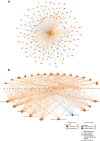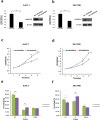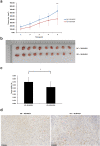Gene expression profiling reveals the genomic changes caused by MLN4924 and the sensitizing effects of NAPEPLD knockdown in pancreatic cancer
- PMID: 34874801
- PMCID: PMC8837228
- DOI: 10.1080/15384101.2021.2014254
Gene expression profiling reveals the genomic changes caused by MLN4924 and the sensitizing effects of NAPEPLD knockdown in pancreatic cancer
Abstract
MLN4924 inhibits the proteolytic degradation of Cullin-Ring E3 ligase (CRL) substrates and exhibits antitumor activity toward various malignancies, including pancreatic cancer. MLN4924 suppresses tumor growth by altering various key regulator proteins; however, its impact on gene expression in tumors remains unknown. In this study, the genomic changes caused by MLN4924 in pancreatic cancer were examined by gene chip analysis and ingenuity pathway analysis. Eleven pathways were significantly altered (5 activated and 6 inhibited), 45 functions were significantly changed (21 activated and 24 inhibited), and the most activated upstream factor was predicted to be TNF. Of 691 differentially expressed genes, NAPEPLD knockdown showed synergism with MLN4924, as determined by real-time quantitative PCR and high content screening. NAPEPLD knockdown enhanced the effect of MLN4924 on inhibiting proliferation and inducing apoptosis in vitro. In a pancreatic cancer nude mouse model, MLN4924 inhibited tumor growth more significantly in the NAPEPLD knockdown group than in the control group. NAPEPLD expression was higher in pancreatic cancer tissues than in the normal pancreas but was not associated with prognosis. These findings indicate that MLN4924 causes extensive genomic changes in pancreatic cancer cells, and targeting NAPEPLD may increase the efficacy of MLN4924.
Keywords: Pancreatic neoplasms; genetic profile; high-throughput screening assays; molecular targeted therapy; proteasome inhibitors.
Conflict of interest statement
No potential conflict of interest was reported by the author(s).
Figures









Similar articles
-
Chk1 inhibitor SCH 900776 enhances the antitumor activity of MLN4924 on pancreatic cancer.Cell Cycle. 2018;17(2):191-199. doi: 10.1080/15384101.2017.1405194. Epub 2018 Jan 3. Cell Cycle. 2018. PMID: 29157102 Free PMC article.
-
Ubiquitin E3 ligase CRL4(CDT2/DCAF2) as a potential chemotherapeutic target for ovarian surface epithelial cancer.J Biol Chem. 2013 Oct 11;288(41):29680-91. doi: 10.1074/jbc.M113.495069. Epub 2013 Aug 30. J Biol Chem. 2013. PMID: 23995842 Free PMC article.
-
Suppression of tumor angiogenesis by targeting the protein neddylation pathway.Cell Death Dis. 2014 Feb 13;5(2):e1059. doi: 10.1038/cddis.2014.21. Cell Death Dis. 2014. PMID: 24525735 Free PMC article.
-
MLN4924 therapy as a novel approach in cancer treatment modalities.J Chemother. 2016 Apr;28(2):74-82. doi: 10.1179/1973947815Y.0000000066. J Chemother. 2016. PMID: 26292710 Review.
-
Neddylation-Independent Activities of MLN4924.Adv Exp Med Biol. 2020;1217:363-372. doi: 10.1007/978-981-15-1025-0_21. Adv Exp Med Biol. 2020. PMID: 31898238 Review.
Cited by
-
Targeting NEDD8-activating enzyme for cancer therapy: developments, clinical trials, challenges and future research directions.J Hematol Oncol. 2023 Jul 31;16(1):87. doi: 10.1186/s13045-023-01485-7. J Hematol Oncol. 2023. PMID: 37525282 Free PMC article. Review.
-
Inhibition of NEDD8 NEDDylation induced apoptosis in acute myeloid leukemia cells via p53 signaling pathway.Biosci Rep. 2022 Aug 31;42(8):BSR20220994. doi: 10.1042/BSR20220994. Biosci Rep. 2022. PMID: 35880551 Free PMC article.
References
-
- Mizrahi JD, Surana R, Valle JW, et al. Pancreatic cancer. Lancet. 2020;395(10242):2008–2020. - PubMed
-
- Hackert T, Klaiber U, Pausch T, et al. Fifty Years of Surgery for Pancreatic Cancer. Pancreas. 2020;49(8):1005–1013. - PubMed
-
- Conroy T, Desseigne F, Ychou M, et al. FOLFIRINOX versus Gemcitabine for Metastatic Pancreatic Cancer. N Engl J Med. 2011;364(19):1817–1825. - PubMed
Publication types
MeSH terms
Substances
LinkOut - more resources
Full Text Sources
Medical
